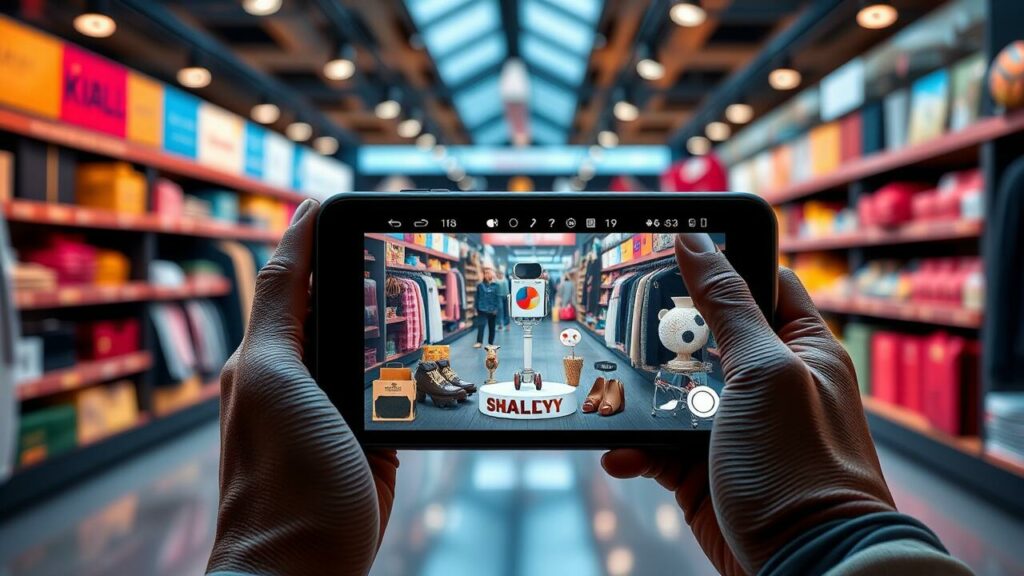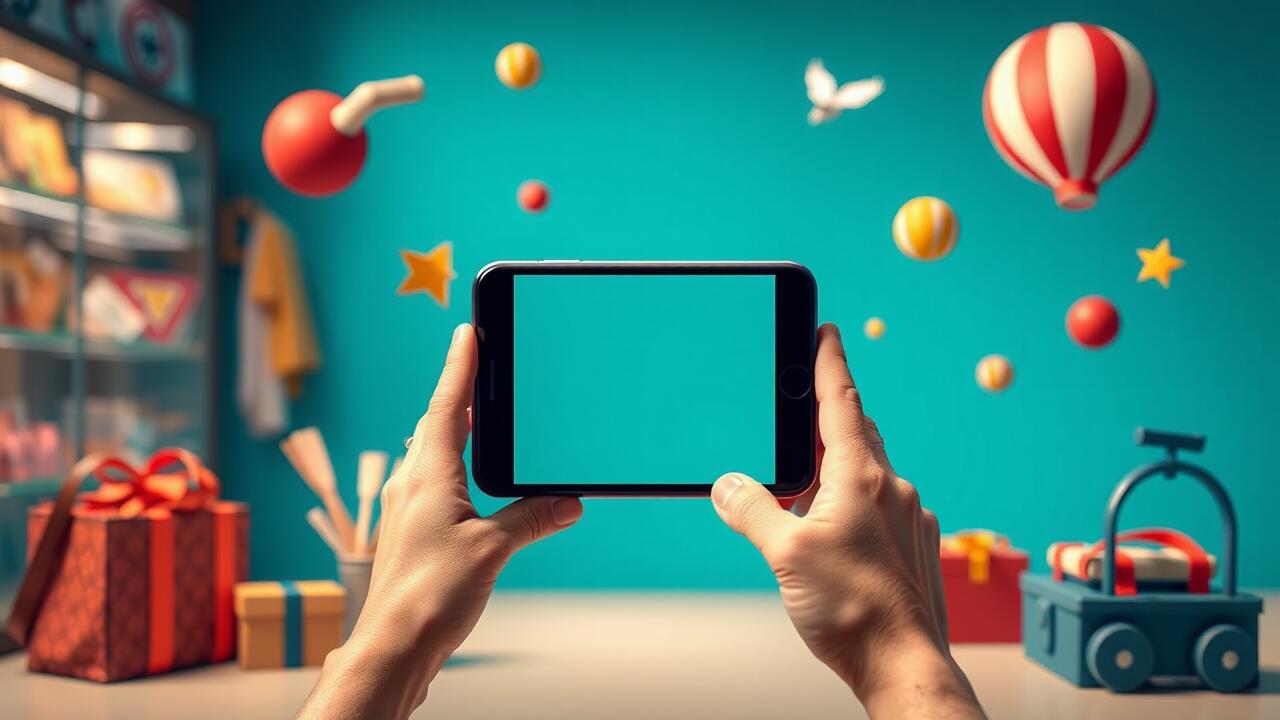Review of Augmented Reality Applications in Retail
Table Of Contents
Comprehensive Review of Augmented Reality Applications in Retail for Enhanced Shopping and Marketing Experiences
Key Takeaways
- Summary of augmented reality’s role in the retail sector and its significance.
- Examination of various augmented reality tools and their functionalities.
- Exploration of shopping interactions enhanced by augmented reality technologies.
- Assessment of marketing approaches utilizing augmented reality techniques.
- Factors to keep in mind while creating augmented reality experiences.
- Insights into upcoming developments in augmented reality within the retail landscape.
Review Of Augmented Reality Applications In Retail | Overview of Augmented Reality in Retail
The Review of Augmented Reality Applications in Retail highlights various dimensions of augmented reality (AR) and its transformative impact on the retail industry. Augmented reality enhances the shopping experience in retail stores, allowing customers to visualize products in their own environments before making a purchase. This technology extends to online retailing, where augmented reality games and interactive features engage consumers in unique ways. Retailers are increasingly adopting AR to create immersive experiences that blend the physical and digital realms, leading to higher engagement and satisfaction. As the lines blur between augmented reality and virtual reality (VR), the potential for innovative marketing strategies grows, driving the evolution of retailing in a highly competitive landscape. The Review of Augmented Reality Applications in Retail serves as a vital resource for understanding these trends and applications.
Review of Augmented Reality Applications in Retail | Definition and Components of Augmented Reality
Augmented reality (AR) represents a transformative approach in the shopping experience, blending virtual elements with the real world. This technology enables retailers to engage consumers through interactive marketing and immersive experiences, providing a competitive edge in both electronic commerce and physical locations like shopping malls. By leveraging mobile applications, multichannel retailers can create engaging platforms that enhance the online shopping experience. The Review of Augmented Reality Applications in Retail illustrates how these applications redefine consumer interaction and drive technology acceptance among buyers.
Key components of AR include the integration of virtual reality (VR) elements and real-time data overlay, allowing for a seamless shopping experience. Retailers utilize AR to create personalized advertisements, guiding consumers through tailored digital marketing strategies. The technology acceptance model helps in understanding user adoption patterns, highlighting the importance of usability and functionality in AR applications. As the Review of Augmented Reality Applications in Retail continues to evolve, it emphasizes the significant role of AR in modern retail and its potential for revolutionizing consumer engagement.
- Augmented reality enhances the in-store shopping experience by allowing customers to visualize products in their own environment.
- Retailers can use AR to provide virtual try-ons for clothing, eyewear, or makeup, boosting customer confidence in product selections.
- The interactivity of AR applications can lead to higher customer satisfaction and brand loyalty.
- AR can streamline the shopping process by offering real-time product information and customer reviews through a mobile interface.
- Integration of AR with social media platforms encourages sharing of experiences, creating organic marketing opportunities.
- Retailers can use AR for educational purposes, helping consumers understand product features and usage through immersive tutorials.
- Ongoing advancements in AR technology promise to further enhance the shopping experience in the future.
The Role of Augmented Reality Technology in Shopping
Augmented reality technology significantly transforms the shopping experience by blending the virtual with the physical world. Retail apps leverage immersive technologies to create interactive environments where customers can visualize products in their homes. This capability enhances customer experiences, particularly in boutiques where shoppers can see how clothing or makeup looks before purchase. The integration of computer vision and mixed reality makes these apps not only functional but also entertaining, driving consumer movement towards digital solutions.
The effectiveness of AR technology lies in its ability to engage users through immersive experiences. Mobile apps equipped with augmented reality features allow consumers to try products virtually, leading to informed purchasing decisions. This innovative approach to shopping redefines traditional retail methods and enhances overall customer satisfaction. As detailed in the Review of Augmented Reality Applications in Retail, these applications provide a seamless blend of technology and consumer interaction, reshaping how people approach their shopping journeys.
Analyzing Augmented Reality Applications
The landscape of retail is undergoing a transformation through the Review of Augmented Reality Applications in Retail, fundamentally altering consumer engagement in e-commerce. This technology creates an illusion that merges physical and digital experiences, allowing customers to visualize various product types in a more immersive manner. Mobile app integration has been pivotal in facilitating this digitalisation, enabling users to interact with items ranging from electronics to fashion from the comfort of their homes. As businesses adapt their models to incorporate these advancements, understanding consumer preferences and behavior becomes crucial for an effective design. The vision of augmented reality in shopping echoes elements found in cinema, where storytelling enhances the buying experience.

Types of Augmented Reality Applications in Retail
Augmented reality applications in retail encompass a variety of technologies designed to enhance the shopping experience. Mobile applications serve as a primary platform, allowing customers to visualize products before purchase. For instance, augmented reality shopping experiences can enable shoppers to see how furniture fits in their living space or how clothing looks on them using their smartphone camera. Wearable devices further elevate this experience, providing hands-free interaction and real-time information. This comprehensive review of augmented reality applications in retail highlights how these technologies not only improve product visualization but also engage customers in a more interactive manner.
The rise of augmented reality technology has led to diverse applications in retail that cater to various shopping needs. Augmented reality apps are increasingly utilized for virtual try-ons, allowing consumers to digitally test products such as cosmetics or eyewear, significantly enhancing their decision-making process. Retailers leverage augmented reality marketing to create immersive campaigns that draw customers in and foster brand loyalty. As augmented reality research continues to evolve, the integration of augmented shopping reality into retail strategies is poised to shape future consumer interactions, making the shopping process more engaging and efficient.
Benefits of Using Augmented Reality Applications
The integration of augmented reality applications in retail creates a transformative shopping experience for augmented reality users. These applications not only enhance consumer engagement but also serve as effective augmented reality advertising tools that drive sales. Review of Augmented Reality Applications in Retail highlights how augmented reality increases customer interaction by providing immersive reality shopping applications. An augmented reality environment allows users to visualize products in their own context, making informed purchasing decisions easier.
Augmented reality services offer retailers the opportunity to stand out in a competitive market. Through augmented reality, brands can deliver tailored experiences that resonate with their target audience. This technology influences consumer behavior by creating memorable experiences that foster brand loyalty. The effectiveness of augmented reality lies in its unique ability to augment the shopping experience, drawing customers into a captivating augmented reality mobile experience that complements traditional retail strategies.
Augmented Reality Shopping Experiences
The Review of Augmented Reality Applications in Retail highlights how retail applications are transforming shopping experiences. By immersing customers in an augmented environment, these reality apps enhance engagement and provide seamless interactions. A retail application refers to the use of augmented reality comforts, allowing consumers to visualize products through AR-based product presentations. Reality mobile applications offer customers enriched experiences, delivering reality-delivered product information right at their fingertips. As retailers integrate these innovative solutions, the potential for captivating and personalized shopping journeys grows, making reality applications essential in modern retailing.
- Customers can try on clothes virtually using AR fitting rooms.
- Furniture retailers allow shoppers to visualize how items will look in their homes.
- AR apps provide 3D models of products to explore from multiple angles.
- Enhanced product information can include reviews and specifications through AR overlays.
- Special promotions and discounts can be accessed via AR features in stores.
- Interactive maps guide shoppers through large retail spaces using AR navigation.
- Brands can create unique experiences, such as gamified shopping, to boost customer engagement.
Enhancing Customer Engagement through Augmented Reality
Augmented reality (AR) is revolutionizing customer engagement in retail environments by providing interactive experiences that captivate retail consumers. A comprehensive review of augmented reality applications in retail showcases how AR-empowered product presentations enhance the shopping experience. Retail fashion technology utilizes AR features, allowing customers to visualize products in real-time, thus bridging the gap between online retailing and physical shopping. With applications like the reality museum application, retailers can turn their stores into immersive experiences that engage customers on a deeper level.
Smart retailing strategies increasingly leverage augmented reality to create attractive online retailing experiences. Shopping applications utilizing AR technology allow retail customers to try products virtually, fostering confidence in their purchasing decisions. Engaging customers through innovative AR visuals not only draws attention but also enhances brand loyalty. These advanced techniques highlight the potential of AR in transforming how retail consumers interact with products, emphasizing the importance of a thorough review of augmented reality applications in retail.
Case Studies of Successful Augmented Reality Shopping
Several prominent brands have embraced augmented reality technologies to enhance their retail environments. A review of augmented reality applications in retail highlights how mobile AR-apps have transformed the shopping experience for retail fashion consumers. For example, major retail fashion stores have developed AR-based apps that allow customers to visualize products in a virtual context, creating an immersive consumer experience. This approach not only boosts customer engagement but also encourages retail app continuance, as shoppers are more likely to revisit apps that provide interactive features.
One notable case study involves a leading fashion retailer that integrated AR into their marketing strategy. This implementation allowed customers to virtually try on clothing and accessories via their smartphones. The success of this initiative illustrates the potential of reality marketing in the retail sector, as it effectively bridges the gap between online and in-store shopping. Such innovative applications demonstrate how retail examines the evolving landscape of consumer expectations while leveraging reality technologies to attract a tech-savvy audience.
Augmented Reality Marketing Strategies
Effective AR marketing strategies leverage innovative ar-based applications to enhance the shopping orientation of retail fashion consumers. Reality marketing refers to the integration of augmented reality experiences that can influence retail consumer behavior and decision-making. By utilizing ar-oriented devices, brands in the retail fashion industry can create immersive shopping experiences that allow customers to visualize virtual products in engaging ways. The Review of Augmented Reality Applications in Retail emphasizes the importance of ar-based presentation modes, which provide a dynamic platform for retail practitioners to connect with their audience and elevate their overall brand engagement. These strategies not only cater to the evolving preferences of consumers but also shape the future of apparel m-retailing, ensuring that businesses remain competitive in a rapidly changing market.
Innovative Ways to Incorporate Augmented Reality into Marketing
Retail brands are increasingly adopting mixed reality technology to enhance their marketing strategies. This integration creates interactive experiences that allow customers to visualize products in their own environment before making a purchase. By utilizing augmented reality in physical stores and major online retailing platforms, brands can transform traditional online product presentation into dynamic reality experiences. The Review of Augmented Reality Applications in Retail highlights how these immersive technologies can significantly improve the shopping experience, ultimately encouraging customer engagement and driving sales.
Employing augmented reality within marketing campaigns enables retailers to provide unique interactive technology that captivates their audience. Successful brands are leveraging AR to create engaging content that blends seamlessly with both online and offline environments. As noted in the retail index report, AR applications not only enhance customer connections but also offer valuable insights into consumer behavior. This innovative approach helps redefine the digital shopping landscape, making it essential for retail brands aiming to stay ahead in a competitive market.
| Brand | AR Application | Purpose |
|---|---|---|
| IKEA | IKEA Place | Allow customers to visualize furniture in their own living spaces. |
| Sephora | Virtual Artist | Enable virtual makeup try-ons with various products. |
| Adidas | AR Shopping Experience | Showcase clothing and footwear in 3D dimensions for better visualization. |
| Pepsi | Pepsi Max AR | Create interactive advertisements that engage consumers in real-life scenarios. |
| DFS | Room Designer | Assist customers in designing their living rooms with DFS furniture. |
Measuring the Effectiveness of Augmented Reality Marketing
Evaluating the effectiveness of augmented reality marketing in retail involves analyzing consumer interactions and purchase behaviors. Many retailers have adopted AR-based grocery shopping and fashion apps to enhance consumer experiences. Employing interactive technologies creates engaging displays that attract shoppers and encourage them to explore products more thoroughly. This dynamic approach not only drives consumer product purchases but also cultivates a memorable atmosphere that resonates with shoppers long after their visits.
To accurately measure the impact of augmented reality marketing, metrics must focus on consumer engagement and satisfaction. Retailers can implement surveys and feedback systems to gather insights on interactive experiences within virtual markets. The rise of reality games and virtual tourism highlights the potential for AR to transform traditional shopping into immersive adventures. A thorough review of augmented reality applications in retail provides valuable data on effectiveness, allowing businesses to refine strategies and further enhance the overall consumer experience.
Design Considerations for Augmented Reality
Effective design is crucial for the success of augmented reality applications in retail, as it directly influences consumer engagement and satisfaction. A thorough review of augmented reality applications in retail highlights the importance of ar-supported features such as virtual mirrors and consumer movement detection. These elements enhance the app experience by allowing users to interact with virtual objects seamlessly, ultimately boosting product novelty and presence in the shopping environment. Mobile app innovations play a significant role in shaping these experiences, particularly in sectors like Italian fashion retailing, where entertainment value perception can dictate consumer preferences. Electronic commerce research continues to reveal strategies for optimizing these applications, ensuring they meet both functional and aesthetic demands.
Best Practices in Augmented Reality Design
Successful design in augmented reality applications for retail hinges on understanding consumer characteristics and their behaviors in various shopping contexts. Effective AR solutions can bridge the gap between on-site retailers and the growing trend of shopping online. By leveraging tourism technology principles, retailers can enhance product/service perception and cultivate a sense of virtual presence. The ability to visualize products in real-time influences consumer purchase desire and boosts product purchase intention, making this a popular application area within the retail sector.
Adopting best practices in augmented reality design involves creating immersive and interactive experiences that resonate with users. Engaging interfaces should prioritize clean navigation and intuitive functionality to facilitate an enhanced customer experience. As highlighted in the Review of Augmented Reality Applications in Retail, well-crafted AR experiences can significantly impact product sales and overall satisfaction, further solidifying the application of AR as a pivotal tool in the evolving retail landscape.
User Experience and Interface Design in Augmented Reality Applications
Creating a seamless user experience in augmented reality applications is crucial for influencing consumer purchase intention. Well-designed interfaces enable stores to present virtual objects alongside advertised products, enhancing the immersive experience for virtuo-physical consumers. High-definition displays contribute significantly to creating realistic representations, bridging the gap between physical and online experiences. A focus on the perceived transaction convenience can also meet consumer expectations, making it easier for shoppers to navigate and engage with the augmented features.
Effective interface design considers the flow of interaction within the augmented reality applications. User-friendly navigation is essential for guiding consumers through various options and experiences. The retail frontline benefits from applications that deliver quick, intuitive access to features, allowing shoppers to interact with virtual objects smoothly. As technology evolves, attention to user experience will define the success of augmented reality in retail, as brands strive to keep pace with changing consumer preferences and expectations. The Review of Augmented Reality Applications in Retail highlights the importance of design in enhancing the overall shopping journey.
| Feature | Importance | Example Application |
|---|---|---|
| User-Friendly Navigation | Guides consumers smoothly through options | IKEA Place |
| High-Definition Displays | Creates realistic product representations | L’Oreal Makeup Genius |
| Intuitive Interaction | Enhances user engagement with virtual objects | Sephora Virtual Artist |
| Transaction Convenience | Simplifies purchasing processes | Amazon AR View |
Future Trends in Augmented Reality for Retail
The evolution of augmented reality applications in the retail sector is poised to significantly reshape shopping industries. Enhanced consumer perspectives highlight the appeal of virtual fitting rooms, allowing customers to interact with physical products in innovative ways. As retailers explore the integration of digital objects, the focus is on creating engaging experiences that amplify entertainment value. Design features that support an omni-customer brand experience can drive temporal purchase intention, aligning with the increasing digital marketing impact on consumer behavior. The future will likely see a shift toward personalized product pricing strategies and interactive interfaces that seamlessly blend the physical and digital realms, paving the way for a more immersive shopping experience. This landscape reflects the insights gained from the ongoing review of augmented reality applications in retail.

Conclusion
The Review of Augmented Reality Applications in Retail highlights how this innovative technology shapes the shopping landscape. By enhancing reality acceptance among consumers, augmented reality creates immersive media experiences that engage shoppers on a deeper level. These applications not only boost visual appeal but also encourage post-purchase product satisfaction, making the shopping experience more enjoyable. As businesses leverage augmented reality to transform marketing strategies, the unique advertisement characteristics of these applications become apparent. Ultimately, the growing integration of augmented reality into consumer services signals a shift in how brands connect with their audiences, paving the way for future advancements in retail experiences.
FAQS
How does augmented reality presence affect online store performance and the management of augmented reality stocks in retail settings?
Augmented reality presence significantly enhances customer experiences in an online store by augmenting product presence, which in turn transforms marketing strategies in the consumer industry. This technology/ar impacts retail consumer behaviour, as augmented reality influences the way customers interact with products, drives engagement, and shapes business models. Furthermore, the reality-the case illustrates how augmented reality augments various retail contexts, leading to improved retail distribution and overall efficiency in managing augmented reality stocks.
How does the integration of augmented reality in retail settings enhance customer experiences and drive engagement?
The integration of augmented reality drives significant enhancements in customer experiences within retail settings. By providing an augmented reality context, retailers can create immersive environments that captivate shoppers. This technology, similar to AR tourism applications, allows customers to interact with products in innovative ways, ultimately fostering deeper engagement and improving overall satisfaction.
How can the technology of augmented reality tourism applications be utilized to create enhanced customer experiences in retail environments?
The technology of augmented reality tourism applications allows retailers to provide immersive experiences that engage customers in innovative ways. By integrating augmented reality features, retailers can create enhanced customer experiences that captivate shoppers, making product interactions more interactive and memorable.
What are the strategic benefits of utilizing augmented reality tourism application technology in retail environments?
The strategic benefits of utilizing augmented reality tourism application technology in retail environments include enhancing customer experiences, improving engagement, and providing interactive features that can draw in more consumers. This technology allows retailers to create immersive experiences that can make shopping more enjoyable and informative, ultimately leading to increased sales and customer loyalty.
What are the potential impacts of augmented reality technology on retail operational efficiency, particularly concerning augmented reality tourism applications?
Augmented reality technology can significantly improve retail operational efficiency by streamlining processes such as inventory management and enhancing user interactions, especially when utilizing augmented reality tourism applications to create immersive experiences that attract customers.
How can retailers leverage augmented reality technology to improve customer interactions and experiences in-store?
Retailers can leverage augmented reality technology to create immersive experiences that facilitate better engagement with customers. This can involve using AR tourism applications that allow customers to visualize products in their own environment or navigate the retail space more effectively, thereby enhancing customer interactions.
What are the key advantages of using technology like augmented reality tourism applications in retail environments?
The technology of augmented reality tourism applications offers several advantages in retail environments, including enhanced customer engagement, improved shopping experiences, and the ability to provide interactive and immersive content that can attract more customers. These applications can also optimize store layout and product placement, ultimately leading to increased sales and customer satisfaction.
How can the technology of augmented reality tourism applications benefit retailers in enhancing their overall marketing strategies?
Retailers can utilize the technology of augmented reality tourism applications to create immersive experiences that attract customers, thereby enhancing their overall marketing strategies. By incorporating augmented reality, retailers can showcase products in a compelling way, leading to increased customer engagement and ultimately boosting sales.
How can augmented reality technology improve customer interactions while utilizing tourism application techniques in retail environments?
Retailers can leverage augmented reality technology by incorporating tourism application techniques to create immersive experiences that engage customers. This integration not only enhances interactions but also allows for impactful marketing strategies, ultimately leading to improved customer satisfaction and increased sales.
What role does augmented reality technology play in enhancing the functionality of retail tourism applications?
Augmented reality technology significantly enhances retail tourism applications by providing interactive experiences that engage customers. It allows retailers to create immersive environments where shoppers can explore products and destinations virtually, ultimately improving customer satisfaction and driving sales through innovative marketing strategies.






